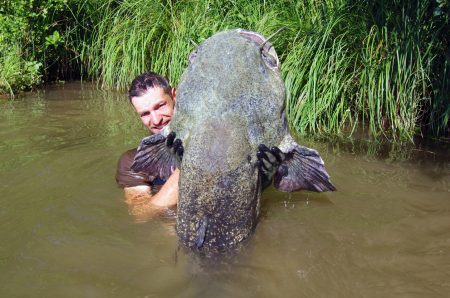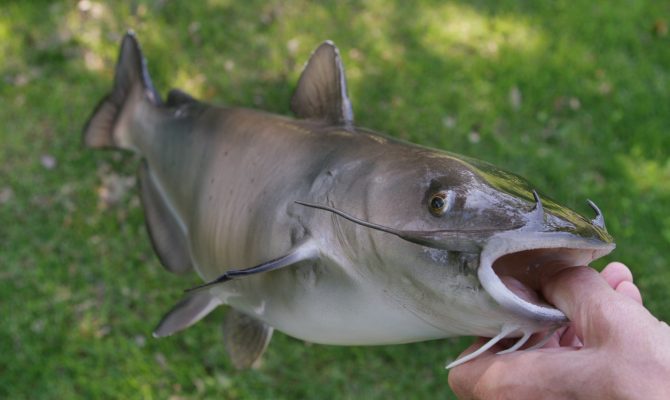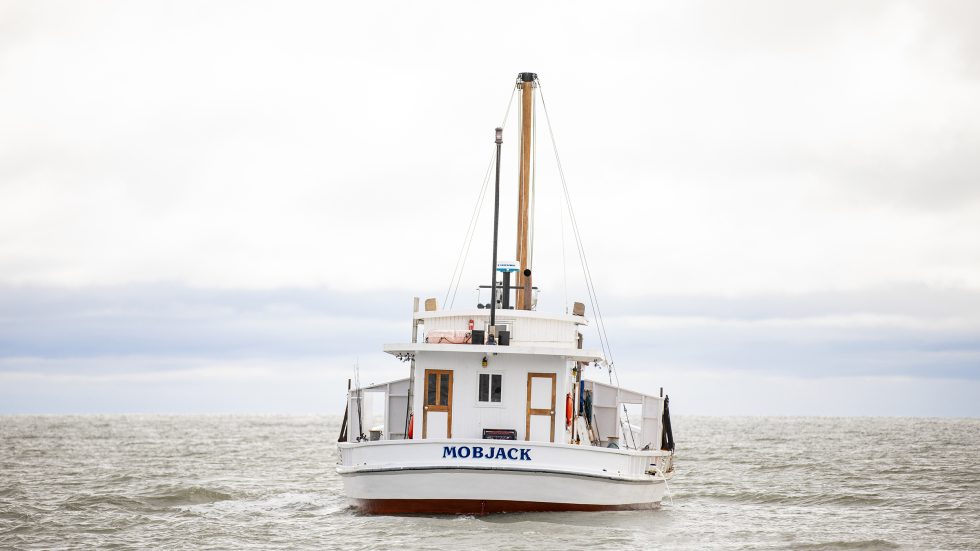“They’re the biggest fish around,” answered Jeremy Leach when asked why he targets Midwest catfish. “There’s nothing to match the rush of catching a fifty- or sixty-pound cat!”
That rush has reached Leach at least a dozen times during the quarter-century he’s been in the hunt. His largest is 58-pound blue cat. He also has a 47-pound flathead to his credit, and more 30- and 40-pound catfish of both species than he can count.
The Indiana native has fished competitively on the Cabela’s and Bass Pro catfish tournament circuits, as well as in local and regional events.
When, Where to Fish
Most mid-summer catfish anglers in search of a big haul stay off the water during the middle of the day, delaying their efforts until the twilight and evening hours, which they think are best for catching catfish. “That’s a myth,” said Leach. “I don’t do any night fishing. I think catfish bite better during the day, and I enjoy it more fishing when it’s light out.”
Leach concentrates on the deepest, darkest waters on a given lake or river during his daylight efforts in the heat of summer. He advises “dog days” catfish anglers to “find the biggest, deepest river you can. You don’t have to worry about thermoclines when fishing rivers, and the biggest fish will be in the deepest part, where they can find the strongest current.
“Current is more important than depth, but if you can find both, you’re in a position to catch the largest catfish in those waters,” Leach continued. “Where you won’t find big fish in the heat of summer is in the feeder streams and tributaries. River fish will follow the bait, and when it gets hot and oxygen levels get low, the baitfish will head for the main stem of the river. And the big catfish follow ’em.”
For lake anglers, Leach advises looking at the deepest area of any reservoir, as well.
“Man-made lakes are usually deepest right up by the dam,” he said. “But you can find holes and the original creek bottom that can be deep and hold big fish, too.
“In lakes, during the summer months, you have to play the thermocline,” Leach said. “The catfish will be right on or above it, either out in the middle of the lake or near shore where there’s structure that’s at the same depth as the thermocline. You find cover and the thermocline in the same area, and you’ll find catfish.”
On the Bait
Of course, finding isn’t catching, and Leach makes sure he has fresh bait to tackle the latter. “The biggest catfish in any water are eating the biggest baitfish they can catch, and here in the Midwest, that’s usually either skipjack herring or shad,” he said.
Leach uses a cast net to catch his own bait, which he fillets for use. “We try to keep to the bait native to the lake or river we’re fishing,” he said, adding that when he can’t get fresh baitfish, he will use chicken livers.
Whether mining the thermocline in a lake or plying deep current in a river, Leach uses a vertical or near-vertical presentation to get his fillets in the face of the catfish below. In lakes, he’ll use his fish finder to locate the depth of the thermocline and then drop his baits to the low-oxygen barrier that big catfish prowl in search of shad and herring that gather there to find cool water. He’ll use a bow-mounted electric trolling motor, wind or current to move the boat at speeds of .5 to .7 mph.
In rivers, Leach will drop his fresh-cut baits into the deepest holes and channels, keeping the fillets anywhere from 1.5 to no more than 4 feet off the bottom.
The Right Rig
Leach uses his own series of 7.5-foot, medium-heavy action Tangling with Catfish rods matched with Abu-Garcia 6500 reels spooled with 100-pound-test Tug-O-War braided line made by Team Catfish. He rigs the working end of the line Carolina-style, using a 6-ounce egg sinker above an 18-inch length of 80-pound-test Cajun Red monofilament tied to an 8/0 Gamakatsu circle hook. The rods are held with special Monster Rod Holders designed for standing up to the pressure of large catfish.
“The catfish don’t care if it’s forty-nine or ninety-nine degrees topside,” he said. “They’re going to eat no matter what, and it takes quite a bit of food to keep a big catfish fed, so they’re usually on the prowl.”
As a matter of fact, when asked what he thinks the most common mistake most catfish anglers make that keeps them from catching bigger summer game, Leach said it’s the bait itself. “Most catfish anglers use baits that are too small to attract the attention of the biggest catfish in the waters they’re fishing,” he said. “It’s not unusual for us to use a two-pound skipjack for bait.”
That’s a keeper-size channel cat or bullhead for many Heartland anglers!

Hitting it ‘Big’
What makes a “big” catfish according to Jeremy Leach?
- River-caught channel cat: 15 lbs.
- Lake-caught channel cat: 25 lbs.
- Flathead cat (river or lake): 50 lbs.
- Blue cat (river or lake): 70 lbs.
This article was originally published through Heartland boating by Dan Armitage.




